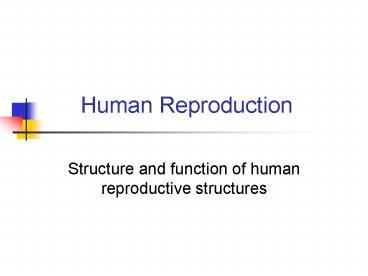Human Reproduction - PowerPoint PPT Presentation
1 / 28
Title: Human Reproduction
1
Human Reproduction
- Structure and function of human reproductive
structures
2
Sexual reproduction terms
- Gametes--specialized reproductive cells
- Ova (eggs)--female gamete
- Sperm--male gametes
- Zygote--formed from fusion of gametes nuclei
(fertilization)--fertilization and birth brainpop
animation - Result offspring have genetic information from
2 parents - Brainpop intro to reproduction
3
Female Reproductive anatomy
- Ovaries(2)--produce eggs (ova pl., ovum sing.)
- produce sex hormones
- At birth, female has all the eggs she will ever
have (approximately 2 million) - At puberty (sexual maturity), 400 eggs will
mature - Each month, one ovary releases an egg into
oviduct (fallopian tubes)--long tube that leads
to the uterus - Fertilization normally takes place in oviduct
4
Female anatomy
- Uterus--muscular pear-shaped organ into which
the egg travels (even in not fertilized) - If egg is fertilized, implants in wall of
uterus--gtpregnancy - If not fertilized, egg disintegrates within 24
hours after ovulation - Cervix--narrow portion at the bottom of
uterus--provides opening to uterus from vagina - Vagina--muscular tube connects uterus to outside
of body - Birth canal through which infants pass when born
5
(No Transcript)
6
(No Transcript)
7
(No Transcript)
8
(No Transcript)
9
Male reproductive anatomy
- Testes(2)--found in the scrotum (pouch of skin)
outside of body--keeps testes away from heat of
body - Produce sperm in males at puberty (13 years old)
in seminiferous tubules - Produce sex hormones
- Sperm require 74 days to develop millions
mature each day. Many needed because few will
survive / reach egg - Sperm contains
- Head--contains genetic material (DNA)
- Midsection--has mitochondria for energy
production - Tail--motility (movement) for travelling to egg
10
(No Transcript)
11
(No Transcript)
12
Male reproductive anatomy
- Epididymis--long, coiled duct that stores sperm
until ejaculation, which moves sperm out of the
body - Vas deferens(2)--tubes that rapidly transport
sperm from epididymis out of body
13
Male reproductive anatomy
- Penis--male organ of sexual intercourse and urine
excretion - Urethra--tube through which sperm (and urine)
move out of the body - Semen--thick, white fluid that carries sperm
- contains secretions
- seminal vesicles (2)--fructose for sperm
nourishment - prostate gland--basic solution to neutralize
acidic environment of vagina - Cowpers (bulbourethral) gland--provides
lubricant also helps to clean urethra - During ejaculation, 5 mL of semen released with
300 million sperm cells
14
(No Transcript)
15
(No Transcript)
16
Sexual intercourse
- Penis becomes rigid with arousal due to increased
blood flow - Vagina becomes lubricated with arousal
- Ejaculation caused by involuntary muscle
contractions - Sperm-containing semen released into vagina
- Sperm travel toward oviduct, although only
thousands survive the 1 hour trip - Fertilization--sperm release enzymes that change
the outer layer of egg so sperm can enter - Once one sperm enters, cell membrane of egg
changes so no more sperm can enter--How do you
get twins? (animation) - Zygote (fertilized egg) travels to uterus for
implantation and is nourished by blood flow from
mother during pregnancy
17
QUIZ--Hormones and Menstrual Cycle
- 1. Specifically, what body system deals
with/controls hormones. - 2. Name 3 organs in the human body that
produce/control hormones - 3. Name one of the sex hormones mentioned in the
reading (other than estrogen, progesterone, and
testosterone)
18
Hormones and their control
- Endocrine system regulates hormones (chemical
messengers) - Sexual development and secondary sex
characteristics - Males--deeper voice, facial hair, etc.
- Females--widening hips, breast development
- Effect is slow and long-lasting
- Nervous system--response is quick and short
- Feedback control of hormones
- One hormone often stimulates organ, while another
inhibits it - Negative feedback--product of process stops
process - Positive feedback--product of process accelerated
process - Insulin and glucagon from pancreas control blood
sugar
19
Sites of hormonal control
- Anterior pituitary (endocrine gland in
brain)produces - 1. Luteinizing hormone (LH)
- 2. Follicle stimulating hormone (FSH)
- Hypothalamus (in brain)
- Regulates release of FSH and LH by acting on the
pituitary - Controls blood pressure, body temp., emotions
- Makes ADH and oxytocin
20
Hormones in males
- FSH stimulates maturation of the testes and sperm
- LH stimulates release of testosterone (male sex
hormone) from the testes - Testosterone stimulates
- Sperm production, erection, and ejaculation
- Secondary sex characteristics
21
Hormones in females
- Menstrual cycle-- monthly cycle that releases
egg (ovum) - Ovulation--release of an egg (ovum)
- Estrogen and progesterone--major female sex
hormones - 1. Produced by the ovaries
- 2. Stimulate sexual maturity
- 3. Regulate menstrual cycle (in part)
22
Menstrual cycle
- Approximately 28 days
- Ovulation (release of egg at about day 14)
- Sperm survive 72 hours egg survives 24
hours--gtFertilization can occur within about a
four-day window - If egg is not fertilized
- 1. Hormone levels drop
- 2. Decreased blood flow to lining of uterus
- 3. Part of the lining of uterus disintegrates
and passes to outside of body (menstruation) - loss of 50 mL to 150 mL of blood
- Lasts 3 to 7 days
23
(No Transcript)
24
Specific menstrual hormones
- FSH--causes maturation of egg inside a sac
(follicle) on the surface of ovary - Estrogen--secreted by the developing follicle
- 1. Stimulates secretion of LH (stimulates
ovulation and the production of estrogen) - 2. Stimulates thickening of inner lining of
uterus - Progesterone--maintains thickness of lining of
uterus and promotes pregnancy (implantation of
fertilized egg) - Corpus luteum formed after ovulation--releases
estrogen and progesterone which together inhibit
LH and maintain thick uterine lining
25
(No Transcript)
26
(No Transcript)
27
(No Transcript)
28
Menopause
- Profound hormonal changes in women
- Signals end reproductive phase of life
- Occurs 45 - 50 years old









![⚡[PDF]✔ Reproductive Rights as Human Rights: Women of Color and the Fight for PowerPoint PPT Presentation](https://s3.amazonaws.com/images.powershow.com/10051481.th0.jpg?_=20240610127)





















